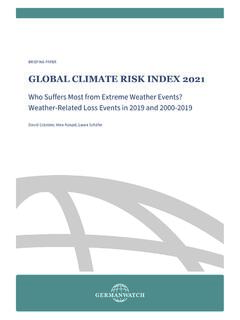Transcription of Global Climate Risk Index 2014 - Germanwatch
1 Global Climate Risk Index 2014 Who Suffers Most from Extreme Weather Events? Weather-Related Loss Events in 2012 and 1993 to 2012S nke Kreft & David EcksteinBRIEFING PAPERTHINK TANK & RESEARCH 2 Germanwatch Summary The Global Climate Risk Index 2014 analyses to what extent countries have been af-fected by the impacts of weather-related loss events (storms, floods, heat waves etc.). The most recent data available from 2012 and 1993 2012 were taken into account. The countries affected most in 2012 were Haiti, the Philippines and Pakistan.
2 For the period from 1993 to 2012 Honduras, myanmar and Haiti rank highest. This year's 9th edition of the analysis reconfirms that according to the Climate Risk Index less developed countries are generally more affected than industrialised countries. Regarding future Climate change, the Climate Risk Index may serve as a red flag for already existing vulnerability that may further increase in regions, where extreme events will become more frequent or more severe due to Climate change. While some vulnerable developing countries are frequently hit by extreme events, there are also some others where such disasters are a rare occurence.
3 The Climate summit 2013 held in Warsaw, Poland, is a defining moment and should mark a turning point for the international community by starting immediately to scale-up its response in addressing Climate change and the increasing loss and damage. The window of time to put the world on track to stay below the 2 C guard-rail is closing rapidly, and Warsaw must trigger new dynamics. Imprint Authors: S nke Kreft and David Eckstein Editing: Birgit Kolboske, Daniela Baum and Gerold Kier Germanwatch thanks Munich RE (in particular Petra L w and Jakob Alfredo) for their support (espe-cially the provision of the core data which are the basis for the Global Climate Risk Index ).
4 Publisher: Germanwatch Office Bonn Office Berlin Kaiserstr. 201 Schiffbauerdamm 15 D-53113 Bonn D-10117 Berlin 0 Phone +49 (0) 228 60492-0, Fax -19 Phone +49 (0) 30 2888 356-0 Internet: E-Mail: November 2013 Purchase order number: 14-2-01e ISBN 978-3-943704-14-3 This publication can be downloaded at.
5 Prepared with financial support from the German Federal Ministry for Economic Cooperation and Development (BMZ). Comments welcome. For correspondence with the authors contact: Global Climate Risk Index 2014 3 Content How to read the Global Climate Risk Index ..3 Key messages ..4 1 Key results of the Global Climate Risk Index 2 Hosting Region of the Climate Summit: Eastern European Group Ignoring Climatic Impacts?..12 3 Advancing the International Response to Climate risks at COP 19 ..14 4 Methodological 5 How to read the Global Climate Risk Index The Germanwatch Global Climate Risk Index is an analysis based on one of the most reli-able data sets available on the impacts of extreme weather events and associated socio-economic data.
6 The Germanwatch Climate Risk Index 2014 is the 9th edition of the annual analysis. It represents one important piece in the overall, more comprehensive puzzle of Climate -related impacts and associated vulnerabilities, but for example does not take into account other important aspects such as sea-level rise, glacier melting or more acid and warmer seas. It is based on past data and should not be used for a linear projection of future Climate impacts. Also, it is important to note that due to methodological reasons a single extreme event cannot be solely attributed to anthropogenic Climate change.
7 Nev-ertheless, Climate change is an increasingly important factor for changing the odds of occurrence and intensity of these events. There is an increasing number of particularly extreme weather events (such as the 2010 Russian heat wave and 2010 Pakistan flood) that scientists too have at least partially attributed to the influence of Climate change. The Climate Risk Index thus indicates a level of exposure and vulnerability to extreme events that countries should understand as warning to be prepared for more frequent and/or more severe events in the future.
8 Due to the limitations of available data, particu-larly long-term comparative including socio-economic data, some very small countries, such as certain small island states, are not included in this analysis. Moreover the data only reflects the direct impacts (direct losses and fatalities) of extreme weather events, whereas for example heat waves which are a frequent occurrence in African countries often lead to much stronger indirect impacts ( as a result of droughts and food scar-city). Finally, it does not include the total number of affected people (in addition to the fatal casualties), since the comparability of such data is very limited.
9 4 Germanwatch Key messages According to the Germanwatch Global Climate Risk Index Honduras, myanmar and Haiti were the countries affected most by extreme weather events between 1993 and 2012. From the ten most affected countries (1993 2012) eight were developing countries in the low-income or lower-middle income country group, while two belong to the upper-middle income countries. Altogether more than 530,000 people died as a direct result of approx.
10 15,000 extreme weather events, and losses between 1993 and 2012 amounted to more than trillion USD (in PPP;1 USD trillion overall losses in original values). In 2012, Haiti, the Philippines and Pakistan led the list of the most affected countries. The 2012 droughts and floods in large areas of the Balkan, eastern Europe and southern Russia in the aftermath of the unparalleled 2010 wildfires have proven the Climate vulnerability of the region that hosts the 2013 Cli-mate Change Conference (COP 19 in Warsaw).





